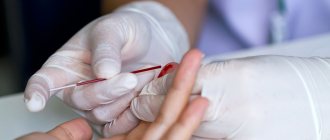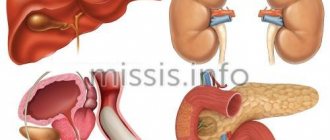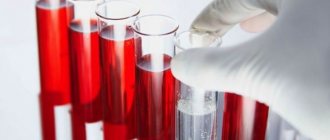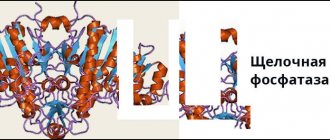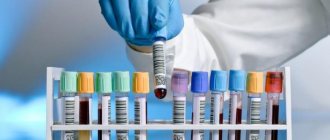How to decipher test results?
A general idea of the number, size and shape of the constituent elements of blood (erythrocytes, platelets, lymphocytes, leukocytes) is given by a clinical blood test. Decoding its results can tell a doctor a lot about the condition of his patient’s body. For each indicator there is a range of reference (normal) values. These norms depend on gender and age. Thus, blood test standards in adults and children can differ significantly. As a rule, modern laboratories indicate reference values in the results form that the client receives. However, deviations from the norm of certain indicators do not yet indicate the presence of pathological conditions. The results of blood tests can be influenced by severe physical activity on the eve of blood sampling, and in women, also by the phase of the menstrual cycle. It is known, for example, that the day before the start of menstruation, the level of leukocytes can rise almost 2 times, so the normal values will differ from the standard ones. Therefore, it is better to contact a specialist for interpretation.
But what to do when it is important to get at least a general idea of the state of your body before going to the doctor? In this case, you can use the “online analysis interpretation” service, where you can enter the indicators of your analysis online and receive a preliminary conclusion. It is important to do this on the website of the exact laboratory where the tests were taken, because different units of measurement for blood parameters may be used. If the tests were taken in a laboratory whose website does not have such a service, then at your service is a calculator for converting units of measurement and a table for deciphering the main indicators of a general blood test. It contains blood test indicators that are considered reference values for middle-aged men and women. The interpretation of blood tests in children varies depending on age. The younger the child, the more his normal blood counts will differ from those of an adult. Thus, the number of leukocytes in the first days of a child’s life can be 2-3 times higher than the concentration of these cells in the blood of an adult. And this will not be a deviation from the norm.
What can affect the result
If the preparation rules are not followed, the result obtained may be incorrect.
An increased PSA concentration can be observed within 10 days after a digital rectal examination, cystoscopy, colonoscopy, transurethral biopsy, prostatectomy or prostate massage, laser therapy, urinary retention, ejaculation on the eve of the study.
The level of total PSA can be affected by medications - androgen antagonists, allopurinol, finasteride, cyclophosphamide, methotrexate.
General blood analysis. Table of reference values
| Index | Patient gender | Norm |
| Hemoglobin | Men Women | 130-170 g/l 120-150 g/l |
| Red blood cells | Men Women | 4.0-5.0 1012/l 3.5-4.7 1012/l |
| Leukocytes | — | 4.0-9.0×109/l |
| Hematocrit (the ratio of the volume of plasma and cellular elements of blood) | Men Women | 42-50% 38-47% |
| Average red blood cell volume | — | 86-98 µm3 |
| Leukocyte formula | — | Neutrophils:
Monocytes: 3-11% Eosinophils: 0.5-5% Basophils: 0-1% |
| Platelet count | — | 180-320·109/l |
| Erythrocyte sedimentation rate (ESR) | Men Women | 3 - 10 mm/h 5 - 15 mm/h |
Price
The price for a quantitative enzyme immunoassay for IgG antibodies to coronavirus consists of the cost of blood sampling and the testing itself. For more details and to make an appointment with a doctor, call the number.
Cost of services
| Name of service | Price, rub.) | Discount |
| (1 k.d.) CORONAVIRUS COVID-19 (SARS-Cov-2), determination of RNA (quality) with collection of biomaterial | 2000 | |
| (CITO 12 hours) NEW CORONAVIRUS COVID-19 (SARS-Cov-2), determination of RNA (quality) with collection of biomaterial | 3500 | |
| CORONAVIRUS COVID-19, PCR, in English with collection of biomaterial | 2250 | |
| (1 k.d.) Antibodies of the IgA class to the coronavirus COVID-19 (Anti-SARS-CoV-2 IgA), semi-quantitative determination, enzyme-linked immunosorbent assay method with sampling of biomaterial | 1150 | |
| (1 k.d.) Antibodies of the IgM class to the coronavirus COVID-19 (Anti-SARS-CoV-2 IgM), semi-quantitative determination with sampling of biomaterial | 1100 | |
| (1 k.d.) IgG antibodies to COVID-19 coronavirus (Anti-SARS-CoV-2 IgG), semi-quantitative determination with biomaterial sampling | 1100 | |
| (1 k.d.) Antibodies of the IgM/IgG class to the coronavirus COVID-19 (Anti-SARS-CoV-2 IgM/IgG), semi-quantitative complex determination, enzyme-linked immunosorbent assay method with biomaterial sampling | 2000 | |
| (2 k.d.) IgA/IgG class antibodies to the COVID-19 coronavirus (Anti-SARS-CoV-2 IgA/IgG), semi-quantitative complex determination, enzyme-linked immunosorbent assay method with biomaterial sampling | 2200 | |
| (2 k.d.) Complex immunity - determination of IgG antibodies to the full-length S protein and to the N nucleoprotein for the COVID-19 coronavirus, semi-quantitative determination with the collection of biomaterial | 2500 | |
| Complex immunity - determination of IgG antibodies to the full-length S protein and to the N nucleoprotein for the COVID-19 coronavirus, field test with collection of biomaterial | 2200 | |
| Differential diagnosis of ARVI, Influenza A and B, coronavirus COVID-2019 (Sars-Cov-2) with collection of biomaterial | 2950 |
Decoding the biochemical blood test
A biochemical blood test in adults shows whether the most important internal organs are functioning correctly: liver, pancreas, kidneys, cardiovascular system, muscles. So creatinine speaks about the work of the kidneys, as well as the state of the muscular system, albumin and bilirubin - about the work of the liver, the level of glucose, cholesterol and triglycerides in the blood - about metabolism. In addition, a biochemical blood test can reveal a lack of essential microelements in the body: you will receive their reference values along with the test results. The normal results of blood tests indicate the coordinated functioning of the main organs; deviation from the norms is a reason for further diagnosis and consultation with a doctor.
Description
Coronavirus infection is an infectious disease caused by new strains of the SARS-CoV-2 virus, identified in December 2021. The infection spreads quickly through droplets or through the air at a distance of about 1.5 - 2 meters. After the viral agent enters the body, the first signs appear within 1 to 2 weeks. Symptoms that may indicate infection with COVID-19:
- high temperature, fever;
- cough;
- dyspnea.
- loss of taste and smell;
- headaches and muscle pain;
- weakness;
- diarrhea, nausea.
Antibodies, also known as immunoglobulins, are large plasma proteins that begin to be produced by the defense system after a viral infection enters the body. The presence of IgG antibodies to coronavirus in the human body is of great diagnostic importance. Class G immunoglobulins are determined in the blood approximately 3–4 weeks after viral invasion or 2–3 weeks from the onset of the first signs of the disease. Sometimes IgG antibodies appear simultaneously with IgM, which are known to be detected in the acute stage of the disease.
What do coronavirus IgG antibodies show? By the presence and level of immunoglobulins in the blood, doctors can judge the presence of infection in the past, and possibly determine the presence of an immune response. The mechanisms of development of the immune response to coronavirus are still being closely studied by scientists. It has not yet been possible to understand whether persistent immunity is formed in those who have recovered from the disease or whether they, like those who have not been ill, continue to be at risk even after recovery.
Analysis for the level of class G antibodies to COVID-19 is carried out using the ELISA method. The test allows you to confirm or refute the fact of the disease.
Reference range norms in children
The reference range in childhood is established based on the age indicator. The characteristics of the child’s body and the intensity of its development imply certain numbers for each age indicator. Not only are they different from adults, but they are also different at each stage of growth. For example, the hemoglobin indicator on the first day is 179-241, in the first month of life it should be 114-176, and from one year to 6 the reference value is 110-139. Children also have distorting factors and individual characteristics in which the result may be out of bounds.
Established normal limits
International reference indicators are accepted only for generally accepted values - hemoglobin, cholesterol or glucose, and each laboratory sets all others based on its own data. Each laboratory may specify different ranges, and this may even depend on the measurement system in which they are reported (eg µg/liter, or µmol/l). The reference value of the analysis means nothing more than the average statistical values of studies taken from healthy patients (the norm, but recorded more correctly, according to scientists).
Reference interval in tests in adults
In tests issued to adults, the age category and gender of the patient being studied must be taken into account. You should not immediately look for standards that should be present in indicators of relative health. Only the attending physician who is familiar with all the components can decipher the analysis. He may advise changing the laboratory or eliminating possible objective distorting factors, monitoring compliance with the necessary conditions, and taking into account the individual characteristics of his patient.
References
1. Chaltsev, B. D., Vasiliev, V. I., Palshina S. G. [etc.]. Clinical guidelines for the diagnosis and treatment of Schörgen's disease with anticentromere antibodies. Scientific and practical rheumatology, 2019. 2. Rheumatoid arthritis. Clinical recommendations. approved Ministry of Health of Russia, 2021. - URL: https://legalacts.ru/doc/klinicheskie-rekomendatsii-revmatoidnyi-artrit-utv-minzdravom-rossii/ (access date: 02/11/2021). 3. Croia, C, Bursi, R, Sutera, D, One year in review 2021: pathogenesis of rheumatoid arthritis. Clinical Experience in Rheumatology, 2021.
How is it determined
To determine the reference interval, the limits of reference values are taken - the largest and smallest indicators included in the relative state of health. If the data obtained for an individual patient falls within the interval between the largest or smallest value, his body is in a state of relative health. To make sure that there is a disease in the body, if the data obtained during the analysis are not included in the reference interval, a repeat test is often prescribed. Indicators in individual studies may change in one direction or another, under the influence of various factors.
The reference interval on the analysis data is determined by conducting research on the target audience (for example, healthy middle-aged men, or people of both sexes who do not have diseases). The upper and lower thresholds are those small numbers (usually 50 people out of a thousand) with the highest and lowest scores. The remaining values will be between these limits. The reference interval takes as the norm the data obtained in 95% of cases.
Factors influencing the reference value
The reference value is influenced by endogenous and exogenous factors of negative significance (diseases, inflammations, infections, colds, etc.). But it is no less susceptible to the simple conditions of everyday existence. In women, these are hormonal disorders (menstruation, pregnancy, ovulation, menopause). Common to all may be:
- psycho-emotional disorders and stress;
- overwork and physical exertion;
- improper or untimely nutrition;
- physiotherapy;
- taking alcohol or medications;
- time of day at which the analysis was carried out.
We should not forget about the individual characteristics of each organism. They may involve going beyond the statistical indicator, but indicate the healthy state of a certain person.

